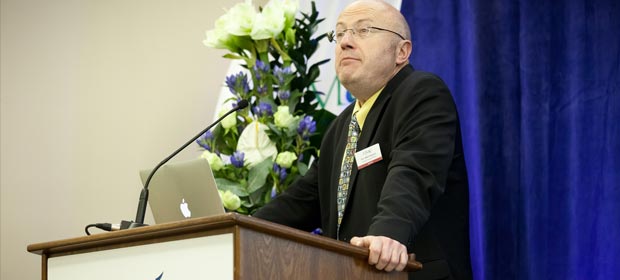Science Foundation Ireland has an annual budget of €150 million and provides a research ‘engine’ of 3,000 people, led by 500 leading scientists, Prof. Mark Ferguson, SFI Director General, and Chief Scientific Adviser to the Irish Government told the Conference.
Science Foundation Ireland has an annual budget of €150 million and provides a research ‘engine’ of 3,000 people, led by 500 leading scientists, Prof. Mark Ferguson, SFI Director General, and Chief Scientific Adviser to the Irish Government told the Conference.

Speaking on “Innovation,”, he said that SFI was founded 12 years ago and had committed €1.5 billion to date. It makes grants to Higher Education Institutes in Ireland based on competitive, international merit reviews for scientific excellence and impact.
It also trains people, builds infrastructure, produces scientific results and technology. It has significant industrial linkages, attracting, anchoring and starting companies. It leverages other research funding, e.g. industrial, EU, charitable and philanthropic.
SCI has 28 clusters/centres of scale, has had 5,740 scientific publications, 80 patent filings, 27 patents awarded, 39 licensed technologies, 10 spin out companies formed, 593 companies partaking in 1,035 collaborations and €156 million leveraged non-SFI funding.
Prof. Ferguson said that from January 1 – December 5, 2012, SFI had links to 4,575 (52 per cent) of the 8,788 jobs announced by the IDA during this period.
“Ireland’s international citation rating is in the global top 20 in all fields.”
“Ireland’s international citation rating is in the global top 20 in all fields. R & D firms in Ireland exported €38 bn in 2000 and €87 bn in 2009. Nine of the top 10 global pharmaceutical companies are in Ireland, as are 15 of the top 20 Medical Technology companies, nine of the top 10 US ICT companies, nine of the top ten software companies, nine of the top 15 internet companies, 14 of the top 21 financial services companies and three of the top six games publishers. We have 1,004 overseas companies employing 146,000 people and exporting approximately €115 billion per annum.
A total of €200 million of new exchequer funds from SFI had been provided for seven world class research centres over six years while there has been €100 million co-investment by over 150 partners. SFI supports key growth areas targeted in the Action Plan for Jobs 2013. It targets research into major social challenges, including health and energy, directly supporting 800 top class researcher positions. SFI is in a position to fund three or four new research centres this year.
“We don’t fund anything unless it is judged internationally to be excellent because we don’t want second-rate research This is all about picking winners,” said Prof. Ferguson.
We spend about €150 million a year and our ambition is to leverage two or three times the money. We spend less than one per cent of our money on administration and everybody is on a five year contract.
Excellence is required but is not sufficient when we make funding decisions. We also need impact which is measurable. What you measure is what you get.
Small countries are not scaled down versions of large countries. They cannot do everything well. We have to prioritise funding.”
There are four high level criteria for funding:
- The area should be associated with a large global market or markets in which enterprises based in Ireland already compete or can realistically compete.
- Publicly performed R&D in Ireland is required to exploit the priority areas and will complement private sector research and innovation in Ireland.
- Ireland has built or is building objectively measured strengths in research disciplines relevant to the priority area.
- The priority represents an approach to a recognised national and/or global challenge to which Ireland should respond.
SCI has four strategic objectives:
- To be the best science funding agency in the world at creating impact from excellent research and demonstrating clear value for money invested.
- To be the exemplar in building partnerships that fund excellent science and drive it into the market and society.
- To have the most engaged and scientifically informed public.
- To represent the ideal modern public service organisation, staffed in a lean and flexible manner, with efficient and effective management.

